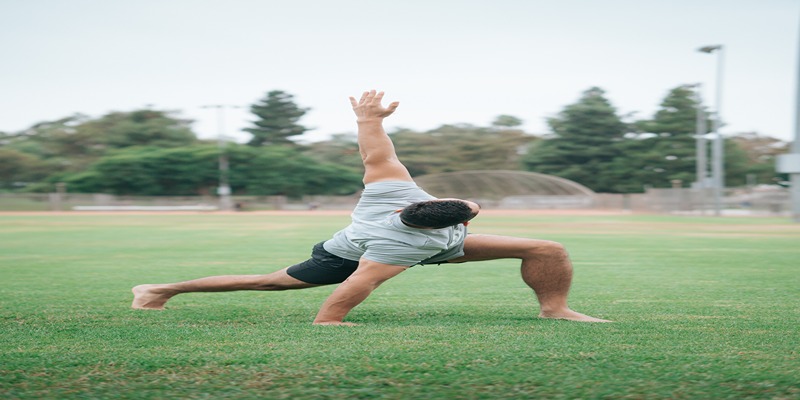A sciatic nerve-generated pain is distinguished by its transmission from the lumbar region to the lower extremities, specifically the quadriceps. To alleviate the discomfort, the following muscular stretches are suggested. An illustration of stretches targeting distinct muscle groups comprises a seated glute stretch and an upright hamstring stretch. With the information contained within this article, one may potentially find solace, attain liberation, and the development of a tranquil state of being. Individuals who have been dogged by sciatica-related limitations may potentially benefit substantially from these stretching exercises.

The Annoyance of Sciatic Pain
Sciatica arises as a consequence of compression or irritation of the sciatic nerve, leading to the expression of excruciating pain. The occurrence of lumbar discomfort that extends to the lower extremities can greatly hinder fundamental functions including walking, reclining, or resting. The impact of this intrusive sensation transcends physical discomfort, permeating various aspects of an individual's existence and significantly reducing its overall standard of living. As a result, performing regular activities such as flexing the body or remaining seated for prolonged periods of time becomes physically demanding. Therefore, it is critical to acquire a thorough understanding of sciatica and implement strategies to alleviate the symptoms that accompany it.
Basics of Sciatic Relief Methods
Why Stretches Are Important
Stretching plays a significant function in mitigating sciatica. The alleviation of sciatic nerve compression is achieved through the mechanism of muscle fiber elongation and strengthening. To reduce the probability of recurrent flare-ups, stretching exercises are implemented to improve blood circulation, enhance flexibility, and facilitate overall mobility. Notwithstanding their apparent simplicity, these segments have demonstrated efficacy. An individual's commitment to maintaining a consistent practice and their own body weight are the only prerequisites. Although medicine is frequently used to provide instant alleviation, stretching is increasingly being acknowledged as a sustainable and non-pharmaceutical alternative. It is worth noting that stretching not only provides immediate relief but also promotes long-lasting health.
Other Methods for Sciatic Nerve Alleviation
Although stretching may offer certain advantages, it is frequently inadequate when used in isolation to treat sciatica. Anti-inflammatory drugs, which are frequently prescribed for the management of pain, typically play a significant role. Furthermore, substantial empirical evidence substantiates the efficacy of alternative therapeutic modalities, including chiropractic care and acupuncture. For certain individuals, the application of compresses at varying temperatures has been demonstrated to be beneficial. These supplementary methodologies can be implemented independently or in combination with stretching routines to enhance their effectiveness. As a result, a comprehensive approach may comprise a number of methodologies, each of which is tailored to accommodate the particular attributes of each person.

Sciatic Pain Stretches: A Closer Look
The stretches offer numerous advantages due to their targeted nature on the principal muscle groups encompassing the sciatic nerve. The subsequent sections will dissect every viable option, clarifying the fundamental process and the benefits it entails.
Pigeon Pose
The traditional yoga asana Pigeon Pose is renowned for its capacity to extend the hip flexors and rotators. In order to perform the motion, adopt a quadrupedal stance by kneeling with both palms on the ground. Continue by articulating one knee posterior to the forearm of the opposing side as you advance it. The leg not positioned posteriorly should be extended. Reduce your body gradually until it is at a minimal distance from the earth. Through the implementation of hip and lower back stretching exercises, this specific posture possesses the capacity to mitigate symptoms that are commonly linked to sciatic nerve pain. Engaging in this position on a repetitive basis facilitates increased flexibility, thereby reducing the strain on neighboring neurons.
Spinal Twist
Anxiously twisting the spine in the Spinal Twist position provides relief. In order to commence, adopt a supine position while completely extending your lower extremities. To execute the designated motion, adopt a seated stance and cross one leg over the other in a cross-positioned manner. Flex one knee and rotate the torso in a counterclockwise direction simultaneously. It is vital to prevent both shoulders from rising above the earth while performing the twisting motion. By focusing on the gluteal and lumbar regions, this stretching exercise attempts to relieve pressure on the sciatic nerve. As a consequence, empirical evidence supports the efficacy of the Spinal Twist method in mitigating sciatica.
Hamstring Stretch
The Hamstring Stretch, a straightforward exercise, possesses the capacity to bestow substantial advantages upon the posterior muscles of the thigh. The primary position to be adopted for this exercise is either a seated or upright stance. This position involves extending one leg while maintaining a gentle forward inclination of the pelvis and torso. While grasping the extended lower limb, exert traction in the direction perpendicular to the body. Through its ability to lengthen the hamstring muscle, this specific stretching exercise is exceptionally effective at relieving lower back tension and sciatica. Additionally, the flexibility to perform this stretch in different locations is a benefit.
The Knee-to-Chest Stretch
Before beginning the Knee-to-Chest Stretch, it is recommended to find a comfortable and ergonomically supportive reclining position on your dorsal surface. This will aid in the execution of the exercise. Ensure that both feet are in an equidistant position on the floor and that the knees are flexed. Presently, establish a secure grasp on the object using both hands and raise one leg in the direction of the torso. Immediate alleviation of sciatica pain is achieved through the relaxation of the lower back and pelvic muscles. By inducing a sustained relaxation of these particular muscle groups, incorporating this stretching exercise into your regimen may help alleviate future sciatica pain.
When to Stretch and How Often
The ideal moment to engage in stretching is dependent on personal inclinations and your routine. A pleasant morning encounter possesses the capacity to positively influence an individual's disposition for the remainder of the day. The evenings offer a considerably required respite from the pursuits of the day. It has been proposed that participating in post-exercise stretching could serve as a viable approach to mitigate muscle discomfort and improve flexibility. Choose an engagement that corresponds with your schedule.
Consistently performing stretching exercises has the capacity to foster significant personal growth. It appears that the achievement of an optimal state of equilibrium is achieved through participation in an activity that transpires between three and five times per week. It is advisable to perform and maintain stretches for a minimum of twenty to thirty seconds. Sustained application of diligence and consistency is essential in the endeavor to discover efficacious treatments for sciatic pain.
Additional Tips for Sciatic Relief
While indirect in nature, the alleviation of sciatica can be accomplished through the application of mindfulness and deep breathing techniques. These therapeutic interventions mitigate stress, leading to a subsequent reduction in muscle tension and subsequent alleviation of nerve compression.
Ensuring appropriate posture, specifically in regards to spine alignment, is critically important when participating in extended periods of seating. To encourage proper posture maintenance, the utilization of ergonomic seats is advised. Consistently maintaining an erect posture results in a progressive decrease in the strain placed on the sciatic nerve.
Conclusion
Combating sciatica necessitates the implementation of a multifaceted approach. Specific stretches such as the Pigeon Pose and Spinal Twist, as well as supplementary activities like deep breathing and ergonomic adjustments, are just a few of the numerous methods to better one's health. Although secondary, time and frequency are extremely significant factors. Implementing a comprehensive strategy increases the likelihood of achieving favorable results.







